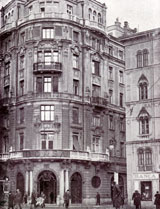Trieste Merchandise Exchange: locations and historical events
Founding
The Trieste Merchandise Exchange was founded in 1775 by Maria Theresa of Austria in 1775 as a form of representation for the local merchant class; in 1894 the Exchange Commission was instituted as its self-governing body. During the period of French domination, between 1811 and 1814, the Merchandise Exchange was transformed into the Chamber of Commerce, but upon the return of the Austrians, the Exchange and the Commission were restored.
When the Austrian Empire instituted the Chamber of Commerce in 1850, the Exchange Commission was maintained as the executive body of the local Chamber of Commerce. Within this institutional framework, the function of representing the merchant class and that of managing the stock market overlapped to some extent.
Self-government over the activities of the exchange proper was entrusted to the brokerage Guild, whose members included stock, merchandise and freight brokers. The Guild Assembly elected an exchange management board made up of four members who performed market monitoring and management tasks such as tracking and publishing the prices and settling disputes between brokers.
When Trieste was annexed to Italy in 1918, the institutional framework of the Trieste Exchange was unified along with those in other marketplaces in the Kingdom that had recently been reformed when the Law of 1913 had gone into effect. This process took place gradually and it was only in 1926 that the new regulations were entirely implemented at the Trieste Stock Exchange.
The Market
During the entire Austrian period, the Trieste marketplace was the seat of intense trading, where financial brokerage for the buying and selling of securities took place alongside that of insurance and wholesale merchandise. The early vitality of the Trieste merchandise marketplace is testified to by the construction of the neo-classical Palazzo della Borsa, built between 1802 and 1804.
Linked through correspondence with the principal European marketplaces, Trieste was the main commercial port of the Austrian Empire, and a market where merchants from different countries operated. During the 19th century, major shipping and insurance companies were established in the city, listing their shares on the market. Although it would appear that the marketplace had already begun to decline before Trieste was annexed to Italy, during the following seventy-five years the Trieste Stock Exchange slowly and inexorably dwindled in importance, partly offset by the prominent listed companies that were located in the city. The law of 1925 which established the amount of authorised stockbrokers set the limit at ten for the Trieste Stock Exchange, but the number of brokers who were registered decreased continually from 5 in 1942 until the closing of the exchange.
Premises
 The first Palazzo della Borsa in Trieste was built between 1802 and 1804; its management was entrusted to a "Commission responsible for the Exchange Building." The building, an example of neoclassical architecture, housed the exchange meetings and had some additional rooms that were rented out to private firms for various uses. Other plans for the construction of new premises were drawn up in 1856 and 1879 but nothing came of either. It was only after Trieste was transferred to Italy that the plan for a new seat was taken up. It was constructed during the 1920s beside the old Palazzo della Borsa, which continues to bear its original name as the Stock Exchange Building even today. Both buildings now serve as the seat of the Chamber of Commerce.
The first Palazzo della Borsa in Trieste was built between 1802 and 1804; its management was entrusted to a "Commission responsible for the Exchange Building." The building, an example of neoclassical architecture, housed the exchange meetings and had some additional rooms that were rented out to private firms for various uses. Other plans for the construction of new premises were drawn up in 1856 and 1879 but nothing came of either. It was only after Trieste was transferred to Italy that the plan for a new seat was taken up. It was constructed during the 1920s beside the old Palazzo della Borsa, which continues to bear its original name as the Stock Exchange Building even today. Both buildings now serve as the seat of the Chamber of Commerce.
